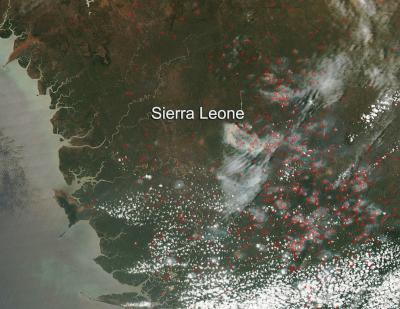Marked in red, hundreds of land use fires burn in the fields across Sierra Leone. Most fires in this region are deliberately set for a variety of reasons, including slash and burn agriculture. When a plot of land becomes exhausted, farmers shift cultivation to another plot where they cut the trees and brush at the beginning of the dry season in January and February. Once the dead plant material has dried, they set fire to it. Such fires peak in March and April right before farming season begins.
From space, MODIS detects thermal anomalies, including fires, flares, and volcanoes. Each MODIS "fire pixel" or fire detection covers one square kilometer, which means that one or more fire is burning in the corresponding one-square kilometer area on the ground. There are hundreds of fire pixels evident in this image, so there are at least that many distinct fires burning in this scene. MODIS tends to undercount fires because it can't detect fires through smoke or clouds, nor does it see small cool fires—a fire type common to land use fires.
Where there is fire, there is also smoke--affecting air quality. Smoke contains soot and other particulates that pose a threat to human health and affect regional climate. Burning also releases greenhouse gases.

Marked in red, hundreds of land use fires burn in the fields across Sierra Leone. Most fires in this region are deliberately set for a variety of reasons, including slash and burn agriculture. When a plot of land becomes exhausted, farmers shift cultivation to another plot where they cut the trees and brush at the beginning of the dry season in January and February. Once the dead plant material has dried, they set fire to it. Such fires peak in March and April right before farming season begins.
(Photo Credit: NASA image courtesy Jeff Schmaltz, MODIS Rapid Response Team. Caption: NASA/Goddard, Lynn Jenner with information from Holli Riebeek.)
This natural-color satellite image was collected by the Moderate Resolution Imaging Spectroradiometer (MODIS) aboard the Aqua satellite on March 24, 2014. NASA image courtesy Jeff Schmaltz, MODIS Rapid Response Team. Caption: NASA/Goddard, Lynn Jenner with information from Holli Riebeek.
Source: NASA/Goddard Space Flight Center